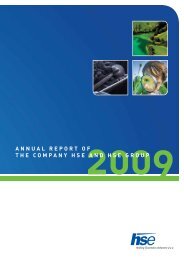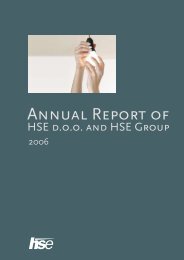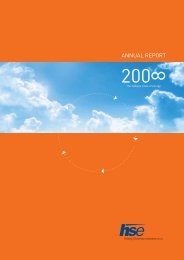Annual report - HSE
Annual report - HSE
Annual report - HSE
Create successful ePaper yourself
Turn your PDF publications into a flip-book with our unique Google optimized e-Paper software.
Changes in allowances for short-term 2012 2011<br />
financial receivables and loans<br />
Balance as at 1 January 449,655 449,655<br />
Collected receivables previously written off and loans -449,655 0<br />
Balance as at 31 December 0 449,655<br />
Changes in allowances for short-term operating receivables 2012 2011<br />
Balance as at 1 January 2,736,960 2,130,436<br />
Written-off receivables collected -353,318 -573,464<br />
Allowances for receivables 5,052,808 1,499,635<br />
Final write-down of receivables -127,374 -319,647<br />
Balance as at 31 December 7,309,076 2,736,960<br />
in €<br />
in €<br />
At the end of 2012, the Group companies possessed a total amount of EUR 7,309,076 of<br />
doubtful short-term operating receivables.<br />
In 2012, the companies were repaid doubtful and disputable short-term operating<br />
receivables in total amount of EUR 353,318.<br />
The allowances for short-term operating receivables mainly refer to receivables that were<br />
due to the Group companies from construction companies, and total EUR 5,052,808.<br />
As at 31 December 2012, the Group had EUR 11,569,608 of overdue short-term operating<br />
liabilities it has already settled.<br />
5.5.8.8.2 Liquidity risk<br />
During financial crisis the liquidity risk management is of extreme importance. The Group<br />
companies manage the liquidity risk successfully, which enables them to ensure optimal<br />
solvency in the settlement of their current liabilities. This comprises diligent monitoring<br />
and planning of short-term solvency, which is provided through a regular coordination and<br />
planning of cash flows on a daily, monthly and annual basis. Due to deteriorated payment<br />
discipline, which is the result of severe economic conditions, all companies, but especially<br />
the controlling company, focus on the risks arising from potential delays in payments by<br />
the customers.<br />
For the purpose of optimisation of companies’ liquidity, cash management is implemented<br />
within the Group. It is performed in accordance with the adopted Internal Regulations of the<br />
Group companies for cash management and cash pooling. The Group’s cash management<br />
consists of borrowing among the Group companies. The primary sources of financing of<br />
short-term deficits of Group companies are surpluses of available cash in other Group<br />
companies. In order to manage liquidity risk, the companies have also credit lines approved<br />
with commercial banks in form of revolving loans and limits on bank accounts. Short-term<br />
liquidity surpluses are allocated to safe and liquid short-term deposits at commercial<br />
banks through cash pooling on treasury account.<br />
5 Financial Report of <strong>HSE</strong> Group<br />
<strong>Annual</strong> Report <strong>HSE</strong> 2012<br />
208<br />
In terms of liquidity risk management, the year of 2012 was one of the most challenging<br />
years for the Group, since the company TEŠ is the investor in the largest Slovenian<br />
investment – construction of the 600 MW replacement Unit 6 in TEŠ. Delays in obtaining<br />
the government guarantee for long-term loans from EIB in the amount of EUR 440<br />
million, had a huge impact on the liquidity of the companies <strong>HSE</strong> and TEŠ, as well as on<br />
other companies of the <strong>HSE</strong> Group. As a matter of fact, all activities were aimed at ensuring<br />
short-term bridge financing of the TEŠ’s liabilities arising from the discussed project,<br />
before the company was able to draw the long-term loans from the financial institutions<br />
EIB and EBRD. Since in line with provisions of the contracts with the two banks TEŠ cannot<br />
obtain short-term loans on financial markets, it was forced to bridge financing of the Unit<br />
6 project through borrowing within the scope the <strong>HSE</strong> Group cash management and with<br />
proper assets. As the Group does not possess a sufficient amount of available funds to
















